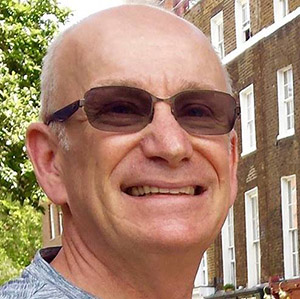
Michael Russell
When Michael Russell joined the USC Shoah Foundation staff in 2008, it wasn’t the first time his family had crossed paths with Holocaust survivors.
His dad, Sonny, worked with the United Nations Relief and Rehabilitation Administration after World War II, helping child Holocaust survivors get settled in England. Sonny even got to know Mayer Hersh, a well-known Holocaust survivor whose testimony is in the Visual History Archive.
Today, Russell is carrying on his father’s legacy, in a way, as lead web developer in USC Shoah Foundation’s Information Technology Services (ITS) department. Russell came to the United States from Manchester, England, in 1978 and worked as a software developer and programmer. At a previous position at Symantec Peter Norton Group he was part of a team that developed the Norton Desktop for Windows which was very popular in the early 90’s and critically acclaimed for providing “missing” pieces in the earlier Microsoft Windows operating systems.
At USC Shoah Foundation, Russell is responsible for creating and managing the data and software infrastructure of the Visual History Archive. His latest projects include developing the applications used by indexing staff, managing a Czech-language keyword thesaurus for the archive, and streamlining the department’s process for integrating new testimony collections into the Visual History Archive.
New technology is making it possible for the archive to be accessed anywhere in the world, by anyone – so a challenge Russell often wrestles with is making sure the archive is available to those who need it, but still has appropriate security measures in place to protect it.
For example, he has been working on making the Institute’s indexing software faster and more user-friendly, so staff who are indexing new testimonies can work from anywhere.
“They can take their MacBooks and sit in Starbucks and it’ll be easier for them to do [their work],” Russell said. “But we have to be cognizant that we don’t open [the archive] up too much. We want easy access but you don’t want it so easy that someone will come in and do something bad.”
Another project that he hopes to complete in the next few months is revising how group interviews are indexed in the Visual History Archive. While USC Shoah Foundation’s original Holocaust collection doesn’t include many interviews with more than one survivor, there are about 200 testimonies in the Institute’s new collections from the Armenian Film Foundation, Canada and San Francisco that include several survivors. Russell has designed a system that allows each person in the interview to be indexed and searchable independently.
Russell said there are so many new and different projects to work on that sometimes the hardest part of his job is narrowing his focus to just one task at a time – though he wishes he could do everything.
His seven years and counting at USC Shoah Foundation are a constant learning experience, but the end result is very meaningful to him, Russell said.
“I’m really mindful of the fact that for 12 years before me there were engineers and database experts working on [the archive] so you have to give credit to all those people. I work with really smart people every day so I learn a lot,” Russell said. “Our mission here is to create a better life for our kids, and that’s really gratifying for me. I’m hoping we’ll look back in a few years and feel that we’ve made a difference.”